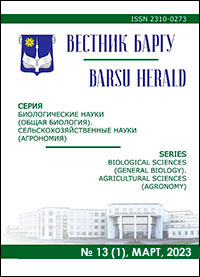ALLOCHTHONOUS FOSSILS IN THE UPPER CENOZOIC DEPOSITSOF BELARUS. PRELIMINARY RESULTS OF THE STUDY.PART I: LOWER PALEOZOIC
Keywords:
allochthonous fossils; characteristic fossils; redeposition; Lower Paleozoic; Cambrian; Ordovician; Silurian; Pleistocene of BelarusAbstract
Allochthonous paleontological material is the result of redeposition of fossils between sediments of different
geological age or genesis. In Belarus, the most diverse association of allochthonous fossils is attributed to the Upper
Cenozoic (mainly Pleistocene) sand and gravel formations. The main area of its origin, probably, covers the territory of Belarus itself, the Baltic countries and the Baltic Sea area. It is also possible that some samples originated from
more remote areas. Pre-Pleistocene allochthonous specimens of Phanerozoic organisms in Belarus are Cambrian,
Ordovician, Silurian, Devonian, Carboniferous, Jurassic, Cretaceous, and Paleogene-Neogene. Permian and Triassic
fossils have not yet been found so far. Representatives of the Ordovician, Silurian, Devonian, and Cretaceous biota
predominate in terms of number and diversity. The allochthonous association of fossils from the Pleistocene sediments
of Belarus differs from the Western European one by the relative scarcity of Cambrian and Jurassic fossils, the moderate
presence of Carboniferous and the greater proportion of Devonian organic remains. To the east of Belarus, the
portion of the Carboniferous component increases, while the Upper Ordovician and Silurian disappear. The reasons for
such differences may lie in the regional geological features of bedrock sediments which are the sources of reworked
fossils. The author does not connect redeposition exclusively with hypothetical glacial transport and admits that a significant
role in their transport could be attributed to floating ice, as well as to the origin of material from local sediments.
Allochthonous organic remains deserve a detailed study as an important source of data about the history of the
formation of the upper intervals of the sedimentary cover of Belarus. Many allochthonous fossil specimens are suitable
for paleobiological and paleoecological studies.
Fig. 53. Ref.: 45 titles.
Downloads
Published
Issue
Section
License
Copyright (c) 2023 Вестник БарГУ Серия "Биологические науки. Сельскохозяйственные науки"
Это произведение доступно по лицензии Creative Commons «Attribution-NonCommercial» («Атрибуция — Некоммерческое использование») 4.0 Всемирная.
Авторы сохраняют за собой право заключать определенные договорные соглашения, касающиеся неисключительного распространения опубликованной версии работы (например, размещать ее в институциональном репозитории, публикация в книге) со ссылкой на ее первоначальную публикацию в этом журнале.





